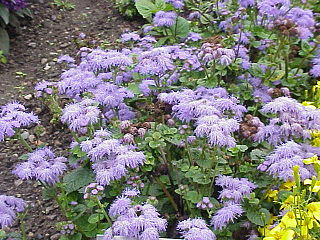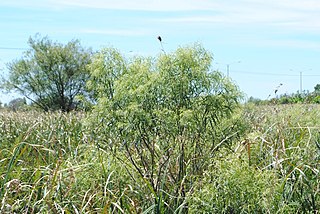Harold Ernest Robinson was an American botanist and entomologist.

Eupatorieae is a tribe of over 2000 species of plants in the family Asteraceae. Most of the species are native to tropical, subtropical, and warm temperate areas of the Americas, but some are found elsewhere. Well-known members are Stevia rebaudiana, a number of medicinal plants (Eupatorium), and a variety of late summer to autumn blooming garden flowers, including Ageratum (flossflower), Conoclinium (mistflower), and Liatris.

Ayapana is a genus of perennial herbs in the family Asteraceae.

Pitcairnia is a genus of plants in the family Bromeliaceae, subfamily Pitcairnioideae. It was named for William Pitcairn, Scottish physician and gardener (1711–1791). The genus Pitcairnia ranks as the second most prolific of the bromeliad family. They are most abundant in Colombia, Peru and Brazil, but can also be found in areas from Cuba and Mexico south to Argentina. One species, Pitcairnia feliciana, is found in tropical West Africa and is the only member of the family Bromeliaceae not native to the Americas.

Greigia is a genus of plants in the family Bromeliaceae, subfamily Bromelioideae. It is native to Latin America from Mexico to Chile. The genus is named in honour of Major General Samuel Alexjewitsch Greig, president of the Russian Horticultural Society in 1865.

Aristeguietia is a genus of about 21 species of flowering plants in the tribe Eupatorieae of the family Asteraceae. It is found from Colombia to southern Peru, with one species in Chile.
Kaunia is a genus of South American shrubs or small trees in the family Asteraceae. Its range is centered in Bolivia but it is also found in Argentina, southern Brazil, Peru and Ecuador.

Pluchea is a genus of flowering plants in the tribe Inuleae within the family Asteraceae. Members of this genus might be known as camphorweeds, plucheas, or less uniquely fleabanes. Some, such as P. carolinensis and P. odorata, are called sourbushes. There are plants of many forms, from annual and perennial herbs to shrubs and trees, and there is variation in the morphology of leaves, flowers, and fruits.

Austroeupatorium is a genus of plants native primarily to South America, including herbaceous perennials and shrubs. The native range is focused on eastern South America and extends as far north as Panama and Trinidad and as far west as Bolivia.
Amboroa is a genus of flowering plants in the family Asteraceae. It is endemic to the highlands of South America. Amboroa was first described as a genus in 1956.
Austrobrickellia is a genus of flowering plants in the family Asteraceae.
Bishovia is a genus of flowering plants in the family Asteraceae.
Critoniella is a genus of South American flowering plants in the family Asteraceae.
Dasycondylus is a genus of flowering plants in the family Asteraceae.
Idiothamnus is a genus of South American flowering plants in the family Asteraceae.

Raulinoreitzia is a genus of South American plants in the tribe Eupatorieae within the family Asteraceae.

Heterosperma is a genus of flowering plants in the sunflower family, native to North and South America.

Proustia is a genus of flowering plants in the family Asteraceae, native to South America and the West Indies.









